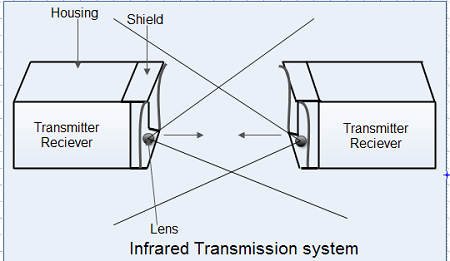Infrared light transmissions have existed for many years and their use having been limited to TV remote controls and wireless slide projector remote controls. However, they now are assuming a position of some, if still limited, importance. Infrared systems use the infrared light spectrum to send a focused light beam to a receiver, much, as would a microwave system, although no reflective dish is used. Rather, pair of lenses is used, with a focused lens employed in the transmitting device and a collective lens in the receiving device as shown in Figure. Infrared is an airwave, rather that a conducted transmission system. Although generally used in short-haul transmission, they do offer substantial bandwidth, but with risks of interference.

Advantages include rapid deployment, especially as there are no licensing requirements as typically is the cue with microwave. Additionally, infrared offers fairly substantial bandwidth at relatively low Cost. However, infrared systems require line-or-sight and suffer from environmental interference, as do microwave system. Error performance is also satisfactory. Additionally, infrared is distance limited. However, infrared often is an attractive alternative to leased lines or private cabled systems for building.
The forward cell can reuse frequencies used in the previous cell. This helps in sharing the same frequency band. Many calls can be handled by one frequency especially where digital phones are used.
Characteristics of Infrared Transmission
Infrared systems need special infrared emitters and infrared detectors. Infrared transmission is performed in two ways. The first method uses the direct modulation and the second uses carrier modulation. The direct modulation scheme is described below as wireless LANs use only direct modu1ation scheme.
Direct Modulation
Direct modulation, often referred as on-off keying, is widely used in optical fiber systems. A light source, usually an LED is directly switched on by a binary 1 and switched off by a binary 0. The direct modulation system is similar to the one shown in Figure. The source bit stream is encoded, using a standard encoding technique prior to modulation. The encoded data is then modulated, using a modulator. Pulse position modu1ation or similar modulation technique is employed to reduce the power requirements. Modu1ated signal is then fed to the LED device. At the receiving side, an optical band-pass filter is used to select the required band that contains the transmitted signal component. Photo-detector produces electrical signal, which is in the modulated form. A demodulator extracts the encoded data from this and a decoder recovers the data in the original form. Direct modulation is commonly used within a room or a small area where the transmitter and the receiver are in the line of sight.
Operating Modes
Infrared links can be used in two different modes. They are direct (point-to-point) mode and diffuse (Omni-directional) modes. In a point-to-point mode, the light emitter is directly pointed to the detector. Hence, low power emitters or less-sensitive photo detectors can be used. This mode of operation is adequate for providing a direct wireless link between two portable devices. Directed systems give a good range of a couple of kilometers and can be used outdoors. It also offers the highest bandwidth and throughput. High performance directed IR is impractical for mobile users and is therefore used only to implement fixed sub-networks.
In the diffuse mode, the infrared light from the source is optically diffused to scatter the light to a wide area. Thus, this mode is suitable for broadcast operation. Omni-directional IR systems provide very limited range and typically reducing the coverage range to 30 – 60 feet, and are occasionally used in specific wireless LAN applications. All the detectors within the room can receive the signal from one transmitter; each with varying phase. The phase variation is due to the variations of path length between the transmitter and receiver. Multiple reflections of light also cause these phase variation. This phenomenon is known as multipath dispersion. This problem will not affect the communication process much in a typical room environment. Signal rate up to 1Mbps can be satisfactorily achievable. Beyond this rate, Inter Symbol Interference causes the major problem.
Benefits and Drawbacks
Benefits IR systems are not bandwidth limited and thus can achieve transmission speeds greater than the other systems. Infrared transmission operates in the light spectrum and does not require a license from the FCC to operate. IR technology was initially very popular because of its high data rates and relatively cheap price.
Drawbacks The transmission spectrum of infrared system is shared with the sunlight and other sources such as fluorescent lights. If there is enough interference from these sources, it can render the LAN useless. IR systems require an unobstructed line of sight (LOS). IR signals cannot penetrate opaque objects.
 Dinesh Thakur holds an B.C.A, MCDBA, MCSD certifications. Dinesh authors the hugely popular
Dinesh Thakur holds an B.C.A, MCDBA, MCSD certifications. Dinesh authors the hugely popular